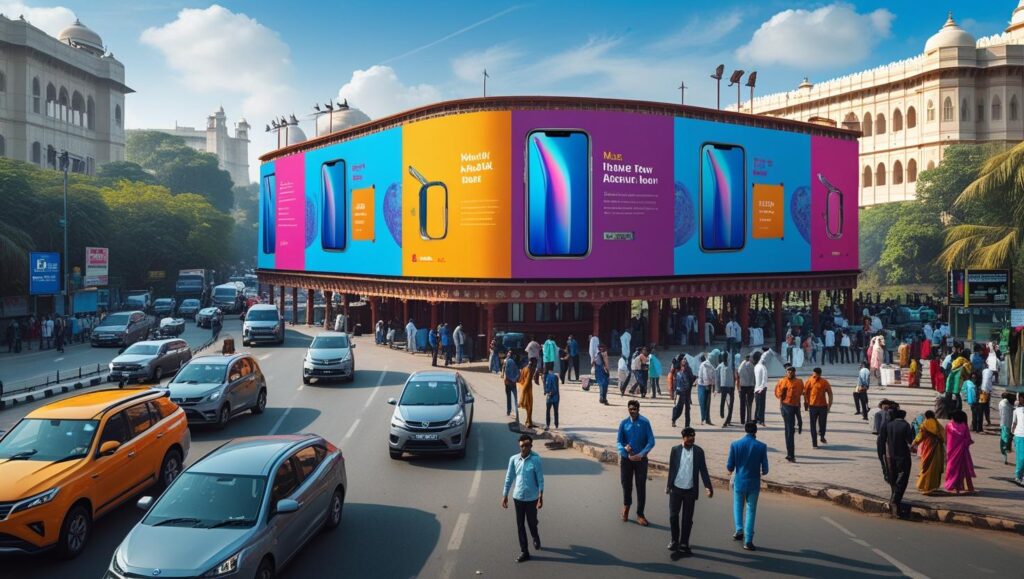Top 5 Mistakes to Avoid in Hoarding Advertising in Delhi
Introduction – The Costly Lessons of the Capital’s Streets for Hoarding Advertising in Delhi
It’s a chilly January morning in Delhi. The city is buzzing — cars honking at ITO crossing, chaiwalas pouring steaming cups, and pedestrians rushing towards the metro.
At a busy red light near Connaught Place, a massive hoarding catches your eye. It’s brightly lit, but… the text is so small you can’t read it from your car. The logo? Buried in a corner. The call-to-action? Missing entirely.
This is a classic example of a wasted hoarding opportunity — the kind of mistake that costs brands lakhs but delivers little in return.
If you’re investing in hoarding advertising in Delhi, avoiding these errors can mean the difference between a campaign that dominates city skylines and one that fades into the background.
In this guide, we’ll uncover the Top 5 Mistakes to Avoid in Hoarding Advertising in Delhi, explain how to fix them, and share insider strategies from campaigns that worked.
Why Hoarding Advertising in Delhi is Still Powerful
Despite the rise of Instagram ads, Google PPC, and influencer marketing, hoardings have something digital can’t replicate — unskippable, 24/7 physical presence in the real world.
Delhi is the beating heart of North India’s economy and politics. With over 3 crore residents and millions of daily commuters, the potential reach of a single prime hoarding is massive.
But location alone isn’t enough. Your campaign has to be strategically designed and executed — and avoiding mistakes is the first step.
Top 5 Mistakes to Avoid in Hoarding Advertising in Delhi
1. Choosing the Wrong Location
Mistake: Placing your hoarding where your audience rarely passes.
Example: Advertising high-end jewellery in an industrial zone where your target customers aren’t present.
Solution:
- Identify your audience (income level, profession, commute patterns).
- Use traffic count reports to select prime visibility areas like Rajiv Chowk, AIIMS Flyover, or Lajpat Nagar.
- Consider the direction of traffic flow — your hoarding should face the busiest side.
2. Overloading the Design with Information
Mistake: Treating a hoarding like a brochure — too much text, small fonts, and busy visuals.
Solution:
- Use 6–8 impactful words only.
- Large, bold fonts readable from 50–100 meters.
- High-contrast colours for day and night visibility.
- Place your brand name and logo prominently.
3. Ignoring Lighting and Weather Conditions
Mistake: Forgetting that Delhi’s foggy winters and scorching summers affect visibility.
Solution:
- Invest in LED lighting for nighttime clarity.
- Use weatherproof printing materials.
- Test visibility in real conditions before launch.
4. No Clear Call-to-Action
Mistake: Leaving viewers impressed but confused about what to do next.
Solution:
- Add QR codes for instant digital engagement.
- Short URLs or phone numbers that are easy to remember.
- Clear offers like “Call Today” or “Visit Now”.
5. Not Integrating with Digital Campaigns
Mistake: Treating hoarding as a standalone effort.
Solution:
- Sync creatives with your social media and Google ads.
- Use the same slogan and design theme across platforms.
- Encourage user-generated content by adding hashtags.
Key Benefits of Doing Hoarding Advertising Right
- Massive Reach – See and be seen by lakhs daily.
- Unmissable Presence – 24/7 exposure in prime areas.
- Boosted Brand Recall – People remember physical ads longer.
- Trust Building – Brands in the real world appear more credible.
- Supports Digital Marketing – Strengthens multi-channel strategies.
Industries That Benefit Most
- Real Estate – Launching luxury projects.
- Automobile – New car and bike promotions.
- Retail Chains – Festival and seasonal sales.
- Politics – Campaign visibility.
- Education – Admission season branding.
How Hoarding Advertising Works in Delhi – Step-by-Step
- Consultation – Define audience and goals.
- Location Hunt – Match sites to your target market.
- Creative Design – Bold, clear, and impactful.
- Approval – Municipal permissions and compliance.
- Installation – Secure and visible placement.
- Monitoring – Check condition and lighting regularly.
- Post-Campaign Analysis – Measure ROI and plan next steps.
Real Client Reviews ★★★★★
⭐⭐⭐⭐⭐ Rohit Malhotra – “We avoided the usual mistakes and saw 2x store footfall in Karol Bagh.”
⭐⭐⭐⭐⭐ Priya Bansal – “Our political hoardings got maximum visibility near major metro exits.”
⭐⭐⭐⭐⭐ Ankit Verma – “A simple, bold design made our restaurant hoarding a city landmark.”
⭐⭐⭐⭐⭐ Meera Kapoor – “Lighting adjustments made all the difference in winter campaigns.”
⭐⭐⭐⭐⭐ Rajeev Sharma – “Integrating with our Instagram ads created amazing brand recall.”
FAQs – Hoarding Advertising in Delhi
Q1. How much should I budget for a premium hoarding in Delhi?
Between ₹15,000 and ₹3,00,000 per month depending on location.
Q2. Which areas give the best ROI?
Connaught Place, Dhaula Kuan, AIIMS Flyover, and Lajpat Nagar.
Q3. How long should I run a campaign?
Minimum 30 days for brand recall; 2–3 months for dominance.
Q4. Is lighting important for daytime hoardings?
Yes, because evenings and foggy mornings affect visibility.
Q5. Can small businesses use hoardings effectively?
Yes, by choosing local hotspots and shorter campaigns.
Conclusion – Avoid Mistakes, Own the Skyline
Hoarding Advertising in Delhi is like owning a piece of the city’s skyline. But with high visibility comes high stakes — a small mistake can waste a big budget.
By choosing the right location, keeping designs simple, ensuring visibility in all conditions, adding a clear call-to-action, and integrating with digital campaigns, you ensure your investment delivers maximum returns.
In the capital where first impressions last, avoiding these 5 mistakes will help your brand stand tall — literally.
